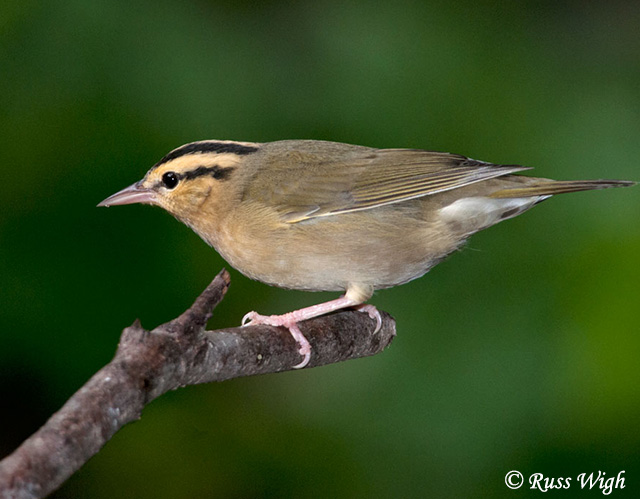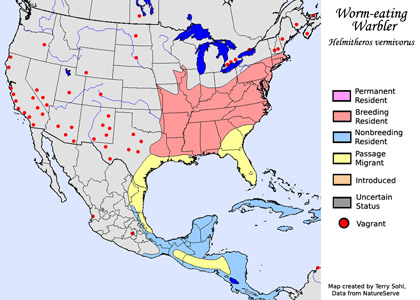| Length: 5.5 inches | Wingspan: 8.5 inches | Seasonality: Migrant |
| ID Keys: Crisp black stripes on warm buffy head, plain brown body | ||
 The Worm-eating Warbler is
another poorly named bird, for they rarely if ever feed on earthworms, although
they do feed heavily on caterpillars.
Relatively unusual for a warbler, they're often quite sluggish, slowly poking
through the forest understory and the forest floor for insects. The female is
extremely attached to her nest, and will often remain, motionless, until a
predator (or curious bird watcher) is within inches of the nest. The
mother will then burst from the nest, feigning injury a short distance away to
try and lure the intruder away from the nest. Their dry
trilling is very reminiscent of the Chipping
Sparrow's song.
The Worm-eating Warbler is
another poorly named bird, for they rarely if ever feed on earthworms, although
they do feed heavily on caterpillars.
Relatively unusual for a warbler, they're often quite sluggish, slowly poking
through the forest understory and the forest floor for insects. The female is
extremely attached to her nest, and will often remain, motionless, until a
predator (or curious bird watcher) is within inches of the nest. The
mother will then burst from the nest, feigning injury a short distance away to
try and lure the intruder away from the nest. Their dry
trilling is very reminiscent of the Chipping
Sparrow's song.
Habitat: Found in deciduous forests during the summer breeding season, especially slopes or shaded banks with a thick undergrowth of shrubs and saplings. Found in dense thickets or forest undergrowth during migration and in winter.
Diet: Primarily feeds on caterpillars and other insects, as well as spiders and occasionally snails.
Behavior: Forages in trees and shrubs for insects, especially on the bark of tree trunks and branches. Will also forage on the ground, probing fallen leaves for insects. Often a relatively sluggish forager, at least compared to most warblers.
Breeding: Non-breeder in South Dakota.
Song: Flat one-note insect-like trilling. Click here to listen to the Worm-eating Warbler's song. Also, click to hear the Worm-eating Warbler's call.
Migration: Summers throughout much of the eastern United States wouth of the Great Lakes. Winters in Mexico and southward.
Interactive eBird map: Click here to access an interactive eBird map of Worm-eating Warbler sightings
Similar Species: Generally distinctive, although possibly confused with Swainson's Warbler.
Conservation Status: Have disappeared or sharply declined in some areas due to habitat loss. Overall, numbers appear to currently be stable however. The IUCN considers the Worm-eating Warbler to be a species of "Least Concern".
Further Information: 1) Patuxent Bird Identification InfoCenter, Worm-eating Warbler
2) WhatBird - Worm-eating Warbler
3) Audubon Guide - Worm-eating Warbler
Photo Information: Photo by Russ Wigh. Original presentation available here from Flickr.
| Click on the map below for a higher-resolution view |
 |
| South Dakota Status: Very rare migrant in the eastern part of the state. |
Additional Worm-eating Warbler Photos (coming soon!)
